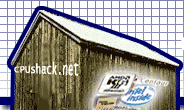Intel Delivers the Next Level of Computing with the New Pentium® II Processor
New Capabilities and Performance Bring Visual Computing to Business
NEW YORK, May 7, 1997 -- Intel Corporation today introduced the Pentium® II processor, which combines innovative and proven technologies to bring new levels of performance and visual computing capabilities to business desktop and workstation users. The Pentium II processor, introduced at speeds of 300-, 266- and 233-MHz, combines the advanced technologies of the Pentium® Pro processor with the capabilities of Intel's MMX™ media enhancement technology. This combination gives corporate users the power to drive enterprise computing, delivers enhanced capabilities to small businesses, and brings the fastest Intel processor ever to workstations.
"With the expansion of visual computing into business, the performance of both processors and PCs must increase more than ever before," said Paul S. Otellini, executive vice president at Intel. "Among new uses, we envision the PC routinely translating all types of raw data into rich 3D models in seconds, helping users better assimilate the information at hand. Interactive business transactions will combine video, realistic graphics and audio to educate or demonstrate new products or services to potential customers.
"To meet those demands, PCs will need to deliver on three key elements of microprocessor performance: floating point, multimedia and integer," Otellini added. "The Pentium II processor delivers superior performance on all three."
The 266- and 233-MHz Pentium II processors are available today in desktop systems from more than a dozen leading computer manufacturers. The 300-MHz processor will be available in workstations in Q3.
Technology Advancements to Meet Three Vectors of Performance
The Pentium II processor combines high performance technological advancements to improve floating point, multimedia and integer performance. They are:
- The innovative Dual Independent Bus architecture, first implemented in the Pentium Pro processor, which addresses the bandwidth limitations of previous-generation processor architectures.
- MMX technology, which has been added to the Pentium II processor to enhance performance for audio, video and graphics applications as well as to speed up data encryption and compression.
- Dynamic Execution technology, which extends the raw performance of the processor by allowing more data to be processed in parallel in a given period of time.
- The Single Edge Contact (S.E.C.) cartridge, which is the delivery vehicle for these technologies, enabling the broad availability of Pentium II processors and providing headroom for future, higher performance processors.
Dual Independent Bus Architecture for Faster Performance
The Pentium II processor bus architecture addresses processor-to-memory bus bandwidth limitations, offering up to three times the performance bandwidth of the single-bus, "socket 7" generation processors, such as the Pentium processor. This translates into overall faster system performance.
Two buses make up the Dual Independent Bus architecture: the L2 cache bus and the processor-to-main-memory system bus. The speed of the dedicated L2 cache bus on the Pentium II processor scales with the speed of the processor. The cache bus on the 300-MHz processor, for instance, runs at 150 MHz, more than twice as fast as the L2 cache on a Pentium processor, which runs at a fixed 66 MHz. The processor-to-main-memory system bus enables simultaneous parallel transactions instead of single, sequential transactions of previous generation processors, further increasing performance.
S.E.C. Cartridge Technology
With the Pentium II processor, Intel is introducing the Single Edge Contact cartridge, an innovative packaging technology to replace older Pin Grid Array (PGA) technology. With this new packaging technology, the components are mounted on a substrate and completely enclosed in a plastic and metal cartridge, forming the processor.
The S.E.C. cartridge will allow Intel to continue to deliver higher performance processors in high volume at mainstream PC price points.
Like the Pentium Pro processor, the Pentium II processor has a closely coupled L2 cache design, which helps the processor achieve higher performance. In the Pentium II processor, the L2 cache is comprised of industry-sourced Burst SRAMs.
Bringing MMX Technology to Business
Since its introduction in January, Intel’s MMX media enhancement technology has brought performance benefits to millions of home users around the world. Intel is working with a number of independent software vendors (ISVs) to bring MMX technology-enhanced applications to the business world. The types of applications that will benefit over time from MMX technology performance include scanning, image manipulation, video conferencing, Internet browsers and plug-ins, video editing and playback, printing, faxing, compression, encryption and office suites.
Product Features, Price and Availability
The Pentium II processor core, with 7.5 million transistors, is based on Intel's advanced P6 architecture and is manufactured on .35-micron process technology. The 266- and 233-MHz speeds, with 512 KB L2 cache are available now. Pricing in 1,000 unit quantities is $775 and $636 for the 266- and 233-MHz parts, respectively. The 300-MHz processor for workstations is priced at $1,981 in 1,000 unit quantities.
Intel continues to provide the industry with different levels of system integration. For computer manufacturers, Intel offers computing building blocks including processors, chipsets and motherboards. For the reseller channel, Intel provides individually boxed Pentium II processors and motherboards available through its Boxed Processor program. Intel’s LANDesk® Client Manager software is also bundled with the boxed motherboards to enable advanced client manageability in support of Intel’s Wired for Management initiative, aimed to reduce the total cost of business computing.
Pentium II processor-based systems offer Intel's highest performance when running the Windows* NT and Windows 95 operating systems. The 300-MHz processor has a SPECint95 rating of 11.6 and a SPECfp95 rating of 7.20. The 266-MHz processor has a SPECint95 rating 10.8 and a SPECfp95 rating of 6.89. The ratings for the 233-MHz processor are 9.49 and 6.43 for SPECint95 and SPECfp95, respectively.
Intel, the world's largest chip maker, is also a leading manufacturer of personal computer, networking, and communications products. Additional information is available at http://www.intel.com.





